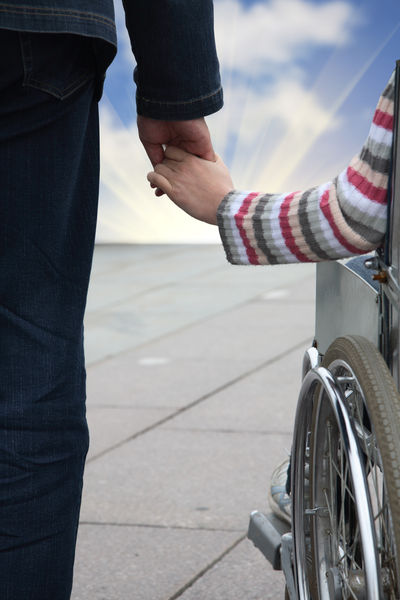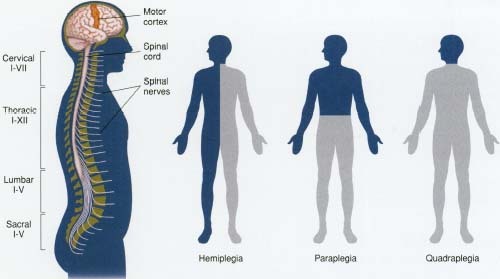Paralysis

Paralysis (pa-RAL-i-sis) is the inability to consciously control the movement of the muscles.
KEYWORDS
for searching the Internet and other reference sources
Muscular system
Nervous system
Spinal cord injury
Sang Lan's Story
As she was warming up for her routine at the July 1998 Goodwill Games, 17-year-old Chinese gymnast Sang Lan prepared to jump over the vaulting horse, a move she had performed thousands of times. But Sang flung herself too forcefully into the vault and landed on her head instead of her feet. The impact snapped the sixth and seventh vertebrae (VER-te-bray) in her neck, damaging her spinal cord and leaving her unable to move from the chest down. Sang's disability is probably permanent. This type of injury is one of the causes of the condition called paralysis.
What Is Paralysis?
Muscle is a special kind of tissue that enables our bodies to move. It is under the control of the nervous system, which processes messages to and from all parts of the body. Sometimes the nerve cells, or neurons, that control the muscles become diseased or injured. When that happens, a person loses the ability to move the muscles voluntarily, and we say that the person is paralyzed.
Paralysis of the muscles of the face, arm, and leg on one side of the body is called hemiplegia ("hemi" means "half") and usually results from damage to the opposite side of the brain. Damage to the nerves of the spinal cord affects different parts of the body, depending on the amount of damage and where it occurred. Paralysis of both lower limbs is called paraplegia, and paralysis of both arms and both legs is called quadriplegia. Paralysis may be temporary or permanent, depending on the disease or injury. Because paralysis can affect any muscle in the body, a person may lose not only the ability to move but also the ability to talk or to breathe unaided.
How Does a Person Become Paralyzed?
Physical injury—for example, sports or car accidents—poisoning, infection, blocked blood vessels, and tumors can all cause paralysis. Defects

Guillain-Barre (gee-YAN ba-RAY) syndrome is an autoimmune disorder in which the body's own cells attack the insulation and core of the nerve fibers, beginning in the hands and feet. In myasthenia gravis (my-es-THEE-nee-a GRA-vis), another autoimmune disorder, a chemical malfunction disrupts the communication needed for muscles to contract.
In rare cases, no physical cause for paralysis can be found. Psychologists call this condition a conversion disorder—that is, a person converts his or her psychological anxiety into physical symptoms of paralysis, but nerve and muscle function are still intact.
Signs and Symptoms
The signs and symptoms of paralysis vary. When the spinal cord is crushed, as in Sang Lan's injury, a person is immediately paralyzed and loses feeling in the affected limbs. When damage to the muscles or central nervous system is caused by a progressive disease or disorder, such as muscular dystrophy or multiple sclerosis, symptoms are gradual and often start with muscle fatigue and weakness. With poliomyelitis (PO-le-o-my-e-LY-tis) and stroke, paralysis comes on suddenly, with little or no warning.
Diagnosis
Information about symptoms and their onset helps the doctor pinpoint the cause of paralysis. With certain genetic diseases that are inherited, such as muscular dystrophy, family medical history provides important clues.
Is Paralysis Treatable?
Aside from poliomyelitis (which can be prevented by vaccination) and brain and spinal cord injuries (which in some cases can be prevented by using appropriate safety measures), it is usually not possible to prevent the conditions that cause paralysis, and most of the time there is no specific treatment. Steroid medications are sometimes given at the time of spinal cord injury to reduce inflammation in an attempt to limit the amount of damage to the spinal nerves. For people with paralysis who must use wheel-chairs, treatment emphasizes exercises and special care to avoid infections and pressure sores. Patients with myasthenia gravis may be offered a drug that helps their muscles contract. Most people with Guillain-Barre syndrome recover on their own. Conversion disorder can be difficult to treat; the underlying psychological problem must be addressed.
Living with Paralysis
Many people with paralysis have normal lifespans, even when the condition is the result of progressive disease. People who are confined to wheelchairs can still drive, swim, fly planes, and even ski. But being paralyzed requires major adjustments to daily living, because the muscles a person usually relies on to do certain things no longer work. For example, for people with severe paralysis, ordinary body functions like urinating and having bowel movements may be difficult tasks. In extreme cases, a person may not even be able to breathe without assistance. Help is available to cope with most cases of paralysis, and people with this condition can often hold jobs, raise families, and participate in life's activities.

Will There Ever Be a Cure?
Ten years ago, no one would have imagined that badly injured nerves could heal. But in the future, people may be able to regain the function they have lost through injury to their motor nerves. For example, experiments with rats and cats have shown that it is possible to repair damaged nerves and that severed spinal cord tissue can be made to grow back. Of course, many questions need to be answered before these approaches can be applied to humans.
"Like a Mind in a Jar"
Jean-Dominique Bauby, editor of the magazine Elle, was 43 and had a wife and two young children when he suffered a stroke that left him with a condition called locked-in syndrome. Bauby was able to think, but he could not speak or move a single muscle in his body except for his left eye. He began to communicate by blinking his eye in a kind of code that a friend painstakingly transcribed letter by letter, first into words and then into sentences. The sentences became a book titled The Diving Bell and the Butterfly. The book was an instant best-seller in France and later inspired readers worldwide.
See also
Amytrophic Lateral Sclerosis
Bedsores (Pressure Sores)
Cerebral Palsy
Incontinence
Multiple Sclerosis
Muscular Dystrophy
Poliomyelitis
Spina Bifida
Stroke
Resources
Book
Reeve, Christopher. Still Me. New York: Random House, 1996. A book by the actor, now paralyzed, who once played Superman.
Magazine
WE Magazine.
A lifestyle magazine for people with disabilities.
http://www.wemagazine.com
Organizations
National Institute of Neurological Disorders and Stroke, Office of
Communications and Public Liaison, P.O. Box 5801, Bethesda, MD 20824. A
U.S. government agency that is a major source of information regarding
neurological disorders and stroke.
http://www.ninds.nih.gov
National Spinal Cord Injury Association (NSCIA), 8300 Colesville Road,
Suite 551, Silver Spring, MD 20910.
http://www.erols.com/nscia/resource
Tutorial
"Paralysis Analysis." An informative tutorial on
spinal-cord injuries and an update on current advances in research.
http://whyfiles.news.wisc.edu/023spinal_cord/index.htm
can he walk and come back to his life
please explane the tertment